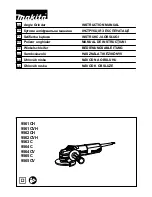
44
45
(Footnotes)
1
See
Locomotive Inertia Effects
on page 3 for further description of this feature. Inertia effects can
be programmed to Standard Throttle Control for more responsive operation.
2
Some electronic power packs do not have a reverse switch. Instead they have
a
reverse button,
which does not cause a rapid change in track polarity to the track and is not suitable for Quantum
operation. See the list of suitable power packs in the
Quantum Analog Reference Manual
(Version
3) at
http://www.broadway-limited.com/
3
Your steam locomotive may not have all lights depending on the model.
4
It is not necessary to wait for the engine Start Up to finish before entering Forward. If you turn
up the throttle, the Start Up sounds terminate and the steam locomotive will immediately go into
normal Forward operation.
5
V-Start is set at 8.5 volts. It is important to note where V-Start is located on your throttle control to
know where you will enter and leave Neutral
.
6
Squealing Brakes occur if the engine exceeds 40 scale-mph (smph) and then slows down to
below 20 smph.
7
If Regulated Throttle Control is enabled (see below) it is important to wait until the locomotive
stops on its own. The engine’s electronic inertia will keep it moving even though you have reduced
the throttle far enough below V-Start to stop the locomotive.
In your attempt to stop the locomotive,
do not try to reduce the throttle so far that all sounds go off.
8
In Neutral, a mechanical bell may have a distinctive turn on effect as the pneumatic clapper gains
full motion to strike the bell. On pull bells, ringing will continue to sound as the bell slows to a
stop.
9
On some power packs that have high internal resistance, the track voltage may rise slightly as the
locomotive slows down and requires less power to operate. As the engine slows, you may need to
reduce the throttle a little more to remain below V-Start.
10
Standard prototype railroad signaling is two hoots before starting in forward and three hoots
before starting in reverse.
11
Some unloaded power packs produce excessive voltage at max throttle and will activate the
Quantum high voltage circuit breaker. When this happens, your engine will stop and emit a series
of hoots until the power is reduced to a lower voltage (see Troubleshooting,
page 42
).
12
POP
is short for “
P
rogram
Op
tion”.
13
The verbal programming responses (such as “Enter Programming” etc.) have a minimum volume
setting to provide programming information even when the system volume is turned all the way
off.
14
You can set System Volume with the Manual Volume Control or with Programming or both. The
Manual Volume Control will determine the range of volume control under Programming; that is,
if you turn the Manual Volume Control down to say, 50%, you will not be able to increase the
volume above the 50% value using Programming.
15
Some lights that are not controlled by the Quantum System may remain on.
16
Setting any volume in Analog will also apply to DCC and vice-versa.
17
Quantum systems have a built in voltmeter that measures the track voltage and announces its
Summary of Contents for Steam Locomotive
Page 47: ...47 ...







































